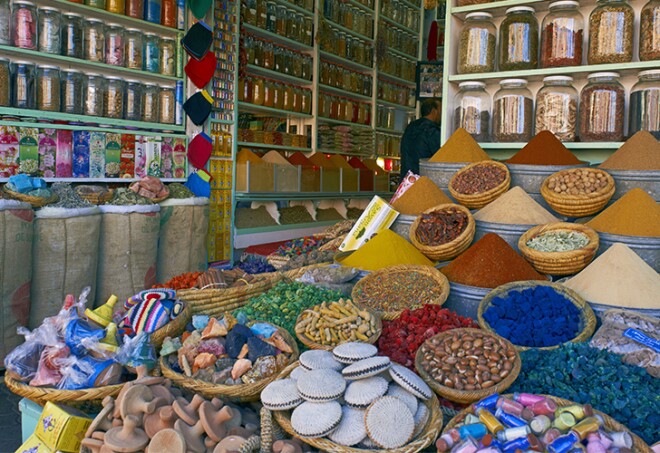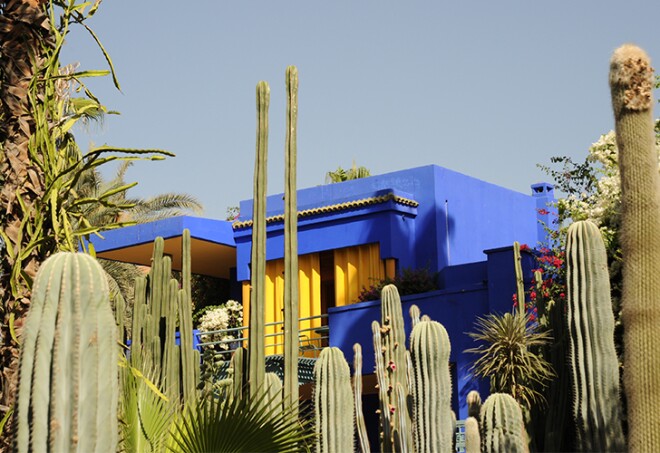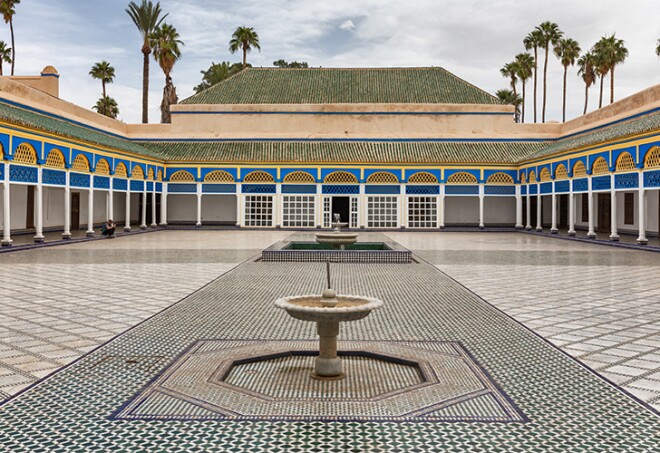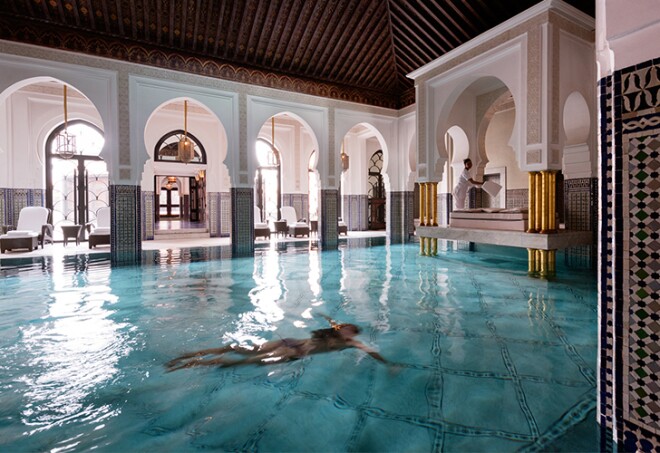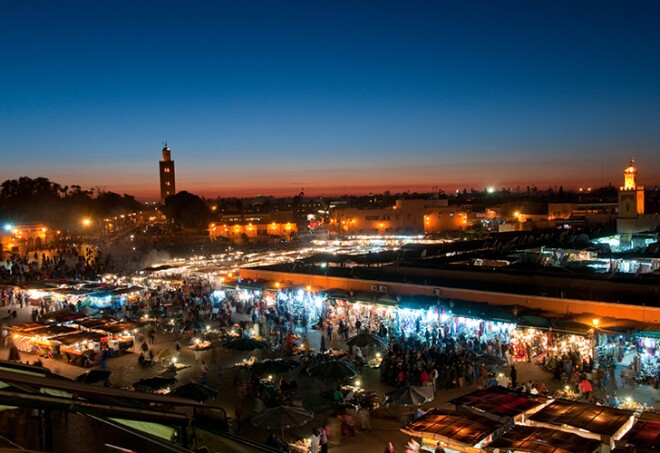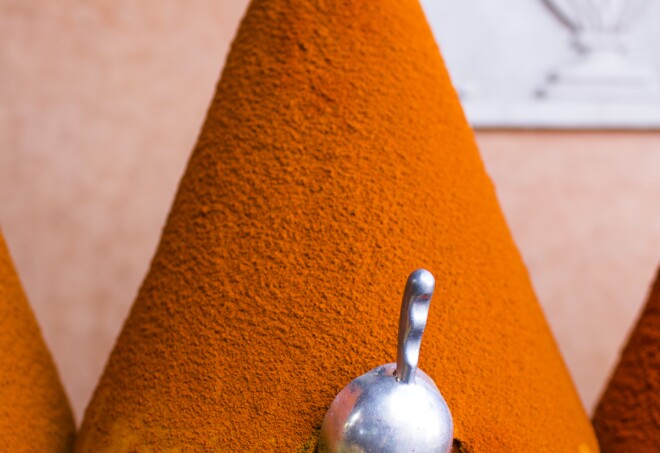The Best Things to Do in Marrakech
Just 50 miles north of the highest peak in the Atlas Mountains, Marrakech is a vibrant city that will let you dip into buildings from the 14th century just as easily as you can modern-day shops. When visiting Marrakech, spend a relaxed, dreamy morning in Jardin Majorelle before heading off to galleries, a museum dedicated to and the former home of fashion designer Yves Saint Laurent, or to snake charmers and other so-very-Marrakech wonders. Nicknamed the “Red City” for the clay used in many of the building, Marrakech is the best Moroccan city for an immersion course in the country’s culture, before you head off to explore the rest of Morocco.
75 Derb Rahba Lakdima, Marrakech 40000, Morocco
If the Djemaa el Fna is the epicenter of Marrakech, the Rahba Lakdima—otherwise known as the Place des Épices, or Spice Traders Square—is surely the epicenter of the medina itself. Bursting with rambunctious energy and high-voltage color, the market is lined on one side by mysterious herbalists and spice traders selling everything from snakeskins to rose petals to ras el hanout (the famous Moroccan spice blend), and by carpet sellers on the other. Venture to the latter’s lair around 4 p.m. when sellers come down from the mountain villages, and you’ll be treated to the spectacle of them plying their trade with the professionals. And in the middle, heaps of woven baskets and woolen skullcaps are piled high. There’s no better place to sit and watch this daily theater unfold than at the Café des Épices, the first of several that have now opened there, but still our favorite for excellent coffee, fresh salads, sandwiches, and tagines.
Rue Yves St Laurent By A-Maps، Marrakech 40000, Morocco
In 1923, the artist Jacques Majorelle acquired a four-acre plot of land just outside the center of Marrakech. Inspired by numerous travels around the country to paint scenes of village life, and funded by painting more illustrious portraits such as that of Pasha Thami el Glaoui, Majorelle was able to build a small studio and house, with enough land to indulge his other passion: ethnobotany. As his career grew, he added a splendid villa, and the garden took on a life of its own, featuring innumerable exotic species from around the world; he added pools and fountains, and, of course, the now iconic, eye-popping Majorelle blue that was lavished on the architecture. The property became so expensive to maintain that the artist was forced to open it to the public until his death in Paris in 1962. The garden gradually fell into a state of disrepair and was slated for development by a hotel chain until French designer Yves Saint Laurent and his partner Pierre Bergé happened upon it during one of their many trips to the Red City. In 1980, they decided to buy it and restore it to its former glory, adding irrigation and doubling the number of plants and gardeners to look after it. They moved into the villa and set about transforming other buildings into what is now the legendary Berber Museum and a boutique. The latter is especially noteworthy for creative director Stephen di Renza’s commitment to reflecting Majorelle’s lesser-known passion for the decorative arts (which is manifest in the exquisite artisanal pieces, leather goods, and jewelry) and Saint Laurent’s inspired use of traditional Moroccan dress, such as the kaftan and djellaba, in haute couture fashion.
Marrakesh, Morocco
Inscribed above the door of the Ben Youssef Medersa in Marrakech reads the following: “You Who Enter My Door May Your Highest Hopes Be Exceeded.” It is an appropriate proclamation for what is arguably the most mind-blowing example of Islamic design and architecture within a Koranic school anywhere in the country. Founded in the 14th century, it was embellished by the Saadian dynasty in 1570 with an ornate bronze doorway, elegant stuccoes, and a marble-tiled patio lined with elaborate mosaics. The prayer room, with its palm and pine cone motifs, looks down into the courtyard from the students’ quarters and gives a splendid helicopter view of the space. During its heyday, the medersa had room for up to 900 students; it was given over to the city as a museum in the 1960s and has remained so ever since.
Avenue Imam El Ghazali
Surely one of the most extraordinary imperial relics of Morocco, the Palais Bahia (“the brilliant”) doesn’t disappoint. Built at the start of the 19th century by architect El Mekki for Si Moussa, the then chamberlain of Sultan Hassan I, the palace showcases a wide range of architectural styles hinting at the chamberlain’s playful spirit, especially after his son inherited it and added his own brand of flamboyant glamour to the place. Women’s quarters bedecked with crimson-and-mustard–striped ceilings, a marble-tile courtyard the size of a soccer field, and extensive salons lined by stained-glass windows are just some of the features of the 20-acre space. In 1912, General Lyautey, the governor of French protectorate Morocco, moved in and added creature comforts such as fireplaces and central heating. In so doing, he attracted a number of illustrious guests, among them the writer Edith Wharton. She described the palace this way: “They came, they built the Bahia, and it remains the loveliest and most fantastic of Moroccan palaces. Court within court, garden beyond garden, reception halls, private apartments, slaves’ quarters, sunny prophets’ chambers on the roofs, and baths in vaulted crypts, the labyrinth of passages and rooms stretches away over several acres of ground.” Follow Wharton’s lead and don’t miss it.
Marrakech Les Jardin De La Menara، Marrakech 40000, Morocco
Declared a UNESCO World Heritage site in 1985, the Jardin Menara was created in the mid-12th century by the Almohad dynasty. Since then, its gardens have been added to and embellished by varying degrees for other sultans but always centered around a huge, flat reflecting pool, which captures the Atlas Mountains in the most sensational way on a clear day and forms the focus of a space that covers nearly 250 acres. An elegant pavilion was installed during the Saadian rule of the 18th century and proved a popular summer escape from the heat among city dignitaries. Unlike other, more formal gardens of the city, Menara’s vast olive groves, orange orchards, and cypresses feel more natural and create a true escape from the fray. Although extremely popular with picnicking Moroccan families in the afternoons, the place is blessedly free of tourists and a lovely, peaceful place for a stroll.
Rue Bin Lafnadek
This delightful gallery is housed in one of Marrakech‘s elegant Saadian town houses, all creamy white plaster walls and subtle bejmat (unglazed terra-cotta) tiled floors. It’s the perfect setting for what began as owner-creators Hamid Mergani and Patrick Manac’h’s private and extensive collection of photographs that document scenes and portraits of Moroccan life over the past century. Today the foundation encompasses a whole lot more, with numerous collectors and photographers such as Daniel Chicault, Ana Muller, and Jean-Pierre Évrard donating or loaning from their own collections. There’s also a terrific little café on the roof for traditional Berber cooking and splendid views of the Atlas Mountains.
Rue Yves St Laurent, Marrakech 40000, Morocco
Constructed by Studio KO architects to echo the weave of fine cloth, the Yves Saint Laurent Museum opened in late 2017 to great fanfare. It was particularly poignant because Pierre Bergé, the longtime partner and business head behind the late designer, had died less than a month earlier. No doubt he would have been delighted with what he saw, for the museum is a game changer with its fresh approach to documenting a subject. Many of Saint Laurent’s lauded haute couture prototypes are on display here against a sleek black backdrop, which makes them appear to almost float across the room, and the library is one of the best in the world on the subject of fashion. A separate auditorium hosts seminars, film screenings, and other events, and the café—simply called Le Studio—has become the lunch favorite of the city’s glitterati. Saint Laurent, you can’t help but feel, would have approved.
Rue de la Liberté, Marrakech 40000, Morocco
Often described as a “Little Paris,” Gueliz has grown into itself in recent years with many of the city’s designers and restaurant owners choosing to set up their flagship fronts there. The Rue de la Liberté is now shoulder to shoulder with fashionable restaurants such as Kechmara for live music, cold beers, and killer burgers; Bistrot Le Loft for platters of French cheese and charcuterie; and the swanky new Asian Resto-Lounge for Chinese steamed dumplings, sushi, and Thai classics; as well as the wine bar Le 68. There’s a Caudalie Spa for great pep-up facials and some must-visit boutiques for snagging made-in-Morocco gifts. Try Lalla, just across the junction at Boulevard el Mansour Eddahbi, for must-have handbags, weekenders, and clutches; Patisserie Al Jawda for delectable Moroccan pastries to take home; and Sidi Marrakech for men’s tailoring. Cross over the main boulevard Mohammed V, and you’ll hit Atika for Tod’s-style suede loafers—brilliant for traveling—in a kaleidoscope of colors. Then hit the Rue Vieux Marrakchi, home to stalwart Moor, for natty embroidered kaftans and cushions, and the envelope-pushing David Bloch Gallery, which showcases the best contemporary urban artists from North Africa.
Marrakesh, Morocco
Spa lovers will enjoy spending a morning or afternoon getting acquainted with traditional Moroccan bathing and beauty treatments at a hammam. Traditionally, these public bathhouses and steam rooms were where both men and women would go for their weekly ablutions: to be first enveloped in olive oil–based soap infused with herbs, then exfoliated with a specially designed mitt, and finally slathered in a full-body clay mask mixed with rose water (hair washing optional). And while this is still an important part of the local culture, ultra-luxurious variations have crept in, especially at places such as the Royal Mansour, where you can bask in sensational interiors before forking out $350 for a hammam and massage fit for a king. The pool at La Mamounia’s glamorous hammam is one of the highlights, so allow plenty of time to make use of it before indulging in their luxury Evasion treatment, which includes an orange-infused olive oil scrub and amber-honey facial exfoliation for $130. If you want to try something a bit more local that still feels like a treat—at a fraction of the cost of the above—head for the Bains de Marrakech, which offers great value for what you get. A 45-minute hammam, including a ghassoul clay body wrap costs $24. Understandably, it gets extremely busy, so book ahead.
Passage Prince Moulay Rachid
Described by writer Tahir Shah as the “greatest show on Earth,” no visit to Marrakech would be complete without a visit to the famous night market on the Djemaa el Fna. Arrive before sunset and park yourself at one of the various cafés with terraces overlooking the square to watch performers set up; then venture into the fray in search of adventure. Silk-clad acrobats, wide-eyed storytellers, sly snake charmers, jangling belly dancers, and capricious monkey handlers all emerge from the darkness, ringing the edge of the food stalls with their own special brand of entertainment. When you tire of the heckling, prowl the market in search of good things to eat: bite-size morsels of grilled lamb rubbed in cumin, sardines fried in chermoula, peppery snails, and sheep’s heads for the brave. Then nudge up alongside a family of locals at the table and settle in for the feast. If you’re nervous about going it alone, you can sign up for a food tour with Canadian tour guide and all-round good egg Mandy Sinclair of Tasting Marrakech; she’ll help you find the best stalls while introducing you to the secrets and delights of traditional Moroccan street food.
Place Ben Youssef, Marrakech-Médina 40000, Morocco
While the story of Marrakesh is relived every day on its streets and in the medina, its museums allow you to slow the pace and take stock of it all. The Marrakesh Museum is housed in a wonderful 19th century palace, the perfect surroundings to show off its collection of traditional arts. The nearby Maison Tiskiwin offers a more eclectic and personal collection showcasing Marrakesh’s position as a trading stop for caravans coming from south of the Sahara. Perhaps the best way to travel back in time is at the Maison de la Photograhie, with its astounding collection of period photos of the city dating back over 120 years. Mortel/Flickr.
Médina, Marrakesh 40000, Morocco
“The Medina is like Brooklyn in that there are all sorts of neighborhoods within it. The Old Jewish Quarter is still a very local place. It feels like Marrakech 30 years ago—a bit rugged and run-down, but it’s cool to wander around in. There are a bunch of shops selling herbs and spices and crafts such as jewelry.”-Moroccan artist Hassan Hajjaj This appeared in the August/September 2014 issue.
Going to the hamman, or public bath-house is an essential part of the Marrakesh experience. After being scrubbed down in the steam room, you’ll never have felt as clean as you like. Upscale hammans now offer the best treatments to entice the spa tourist crowd, with many riads have their own in-house hammam for guests. Choose from a menu of different options, with Moroccan ghassoul (mineral clays mixed with herbs and petals), gommage (scrubs), body wraps and most types of massage on offer. Noted hammams with the full spa experience include Le Bain Bleu and Sultana Spa – but check with your accommodation as to what they offer before booking.

